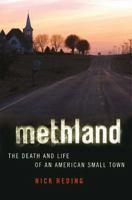
I was sitting on the patio of my favorite bakery on a drizzly Saturday morning, eating a croissant, when the woman doing a crossword next to me noticed the title of the book I was reading: Methland. "Excuse me," she said, "but can you tell me a little about that book?"
It's a title that's bound to pique interest. She told me that she grew up in the sixties and doesn't really know a lot about meth. Indeed, methamphetamine first showed up on the national radar in a big way in the 2000s, and has since captured the public imagination as a drug that's weirdly predominant in rural working-class communities in Iowa, Kansas, Missouri, and all across middle America. It's also started cropping up all over pop-culture, from Breaking Bad to True Blood to Winter’s Bone. People are curious about meth.
The thing I like best about journalist Nick Reding's book Methland is that it transcends a sensationalist true crime attitude to look deeply and thoughtfully at the meth pandemic. "Viewing meth as a crime story vastly oversimplifies the problem," Reding has written, and he's taken pains to craft a narrative that avoids stereotyping, trivializing or caricaturing. After spending four years on and off in the tiny town of Oelwein, IA, getting to know meth from every perspective — addicts, the town doctor, the chief of police, the mayor, the county prosecutor, social workers, the owner of the local dive bar — Reding had the material for a book that would land on the New York Times bestseller list and tell the complicated story of meth in small town America.
Methamphetamine was first widely used in combat operations by Allied and Axis soldiers during World War II — many have even speculated that Hitler, when he devolved into increasingly Parkinson's-like symptoms and a derelict mental state, was addicted to meth. In the 1950s thru the early 80s, meth was often prescribed to suppress appetite and fight depression, among a host of other ailments. Then, in the mid-80s, TV personality Tom Arnold’s sister, Lori, started trafficking illegal meth to Ottumwa, IA, and all over the U.S. Now, like a socioeconomic cancer, illegal meth ravages small-time dealers and cooks like Roland Jarvis, who miraculously survived blowing himself up one night after hallucinating that he saw live human heads in the trees at his mother’s house, and Major, a young man struggling to get clean after hooking up with the Sons of Silence biker gang and fathering a child who was taken away by DHS. Meanwhile, strapped local law enforcement agencies are trying every possible strategy — including banning bicycles on downtown Main Streets — to clean up their towns and rid them of meth, for good.
A true-life Winter’s Bone story, Reding uses Methland as a springboard to discuss the politics of methamphetamine use, its effects on addicts and their communities, and the families and children who, like Ree Dolly, are left behind to try to survive.
